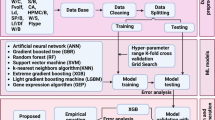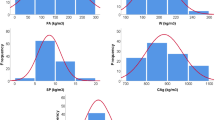Abstract
Selection of the number of neurons in different layers of an artificial neural network (ANN) is a key decision-making step involved in its successful training. Although the number of neurons in the input layer is decided by the number of input parameters, and similarly, in the output layer the number of neurons is fixed by the output parameters, however, the number of neurons in the hidden layer is not fixed, whereby the overall efficiency of the ANN depends upon the correct modeling of the realistic scenario in the form of a neural network. Concrete can be mixed in a huge variety of methods and compositions to achieve a specific or a combination of specific results. These results have been observed to repeat and follow patterns. Furthermore, for several types of concrete mixes, only actual physical trial data are available with no mix design method; this makes achieving different required results very complex and expensive task. Having an ANN to be able to predict a concrete mix to handle such variations will save a lot of time and money and will prove to be a universal mix design tool. A thorough analysis for deciding the number of neurons for mix design of concrete has been carried out in this research. The results of neural networks for a varying number of neurons and layers have been correlated. The data for a number of concrete mixes were sorted and normalized. Properties of concrete constituents like specific gravity of cement, coarse and fine aggregates, dry density of coarse and fine aggregates, cement type, type of mineral admixture, water-to-cement ratio, type and temperature of curing and hardened properties like compressive strength, modulus of elasticity and tensile strength were taken as input parameters. The contents of constituents of concrete such as water content, cement content, coarse aggregates content, fine aggregates content and content of mineral admixtures are regarded as output parameters. For 17 inputs and 5 outputs, it has been discovered that simple neural network with single or double hidden layers performed better that 3 or more such layers.








Similar content being viewed by others
References
ACI Committee 211.1, Standard Practice for Selecting Proportions of Normal, Heavyweight, and Mass Concrete, part 1, ACI Manual of Concrete Practice, 2014.
ACI Committee 211.2, Standard Practice for Selecting Proportions for Structural Lightweight Concrete, part 2, ACI Manual of Concrete Practice, 1990.
ACI Committee 211. 3R-02: Guide for Selecting Proportions for No-Slump Concrete, part 3, ACI Manual of Concrete Practice, 2009.
ACI Committee 211. 3R-02: Guide for Selecting Proportions for No-Slump Concrete, part 3, ACI Manual of Concrete Practice, 2009., part 4, ACI Manual of Concrete Practice, 2009.
BS 5328—Concrete, Part 2, Methods for Specifying Concrete Mixes., 2018
Kavzoglu Taskin (1999) “Determining Optimum Structure for Artificial Neural Networks”, 25th Annual Technical Conference and Exhibition of the Remote Sensing Society. Cardiff, UK, pp 675–682
Shibata, Katsunari, and Yusuke Ikeda. “Effect of number of hidden neurons on learning in large-scale layered neural networks.” 2009 ICCAS-SICE. IEEE, 2009.
Fumumoto, Yuta, Shotaro Owaki, and Moriya Nakamura. “Effect of number of neurons of a neural-network on compensation performance of SPM non-linear waveform distortion.” 2017 Opto-Electronics and Communications Conference (OECC) and Photonics Global Conference (PGC). IEEE, 2017.
Shafi, Imran, et al. “Impact of varying neurons and hidden layers in neural network architecture for a time frequency application.” 2006 IEEE International Multitopic Conference. IEEE, 2006.
Sheela, K. Gnana, and Subramaniam N. Deepa. “Review on methods to fix number of hidden neurons in neural networks.” Mathematical Problems in Engineering 2013 (2013).
Anthony N. Burkett (1991) “Optimization of the Architecture of Feed-forward Neural Networks with Hidden Layers by Unit Elimination”, Complex Systems, pp. 371 -380.
. C Carpenter, William et al. (1994) “Common misconceptions about neural networks as approximators”. Journal of Computing in Civil Engineering, pp. 345-358.
Saurabh Karsoliya (2012) “Approximating Number of Hidden layer neurons in Multiple Hidden Layer BPNN Architecture”, International Journal of Engineering Trends and Technology- Volume3 Issue 6.
L. Prechelt (1998) “Early stopping – but when”, Neural Networks: Tricks of the trade, Lecture Notes in Computer Science, Springer Verlag, Heidelberg.
R. Setiono (2001) “Feed forward neural network construction using cross validation”, Neural Computation, pp. 2865-2877.
Noguchi T (1993) Relationship between compressive strength and modulus of elasticity of high-strength concrete. In Proceedings: the third international symposium on utilization of high strength concrete, symposium in Lillehammer, Norway, pp 1247–1254
I-Cheng Yeh (1999), “Design of High Performance Concrete (HPC), mixture using Neural Networks and Nonlinear programming”, Journal of Computing in Civil Engineering, Vol. 13, ASCE, ISSN 0877-3801/99/0001-0036–0042.
Ziolkowski P, Niedostatkiewicz M (2019) Machine Learning Techniques in Concrete Mix Design. Materials 12(8):1256. https://doi.org/10.3390/ma12081256
Amer Hasan Taher,Layth A. Al-Jaberi And Ahmed Mancy Mosa,(2018) Artificial Neural Network For Mix Proportioning Optimization Of Reactive Powder Concrete. Available from: .Journal of Theoretical and Applied Information Technology, 15th December 2018. Vol.96. No 23
Ching-Yun Kao, Chin-Hung Shen, Jing-Chi Jan and Shih-Lin Hung, (2018), Computer-Aided Approach to Pozzolanic Concrete Mix Design, Hindawi, Advances in Civil Engineering, Volume 2018, Article ID 4398017, 15 pages, https://doi.org/10.1155/2018/4398017
Young BA, Hall A, Pilon L, Gupta P, Sant G (2019) Can the compressive strength of concrete be estimated from knowledge of the mixture proportions?: New insights from statistical analysis and machine learning methods. Cement and Concrete Research 115:379–388. https://doi.org/10.1016/j.cemconres.2018.09.006
Merve Açikgenç et al. (2015), “Using an Artificial Neural Network to Predict mix compositions of Steel Fiber-Reinforced Concrete”, Arabian journal of Science and Engineering, pp. 407-419.
Sourav Das (2015), Prediction of Concrete Mix Proportion using ANN Technique, International Research Journal of Engineering and Technology (IRJET), Volume: 02.
Sh.Charhate, M.Subhedar and N.Adsul, (2018) Prediction of Concrete Properties Using Multiple Linear Regression and Artificial Neural Network, Journal of Soft Computing in Civil Engineering, 2-3(2018) 27-38 http://dx.doi.org/10.22115/SCCE.2018.112140.1041
civilengradil. (2020, July 24). civilengradil/ANN-universal-concrete-mix-design: Release 1 of ANN Universal Mix Design tool (Version v1.0.0). Zenodo. http://doi.org/10.5281/zenodo.3959357
Rumehart David E et al (1986) Learning representations by back propagating errors. Letters to nature 323:533–536
Author information
Authors and Affiliations
Corresponding author
Additional information
Publisher's Note
Springer Nature remains neutral with regard to jurisdictional claims in published maps and institutional affiliations.
Rights and permissions
About this article
Cite this article
Adil, M., Ullah, R., Noor, S. et al. Effect of number of neurons and layers in an artificial neural network for generalized concrete mix design. Neural Comput & Applic 34, 8355–8363 (2022). https://doi.org/10.1007/s00521-020-05305-8
Received:
Accepted:
Published:
Issue Date:
DOI: https://doi.org/10.1007/s00521-020-05305-8




